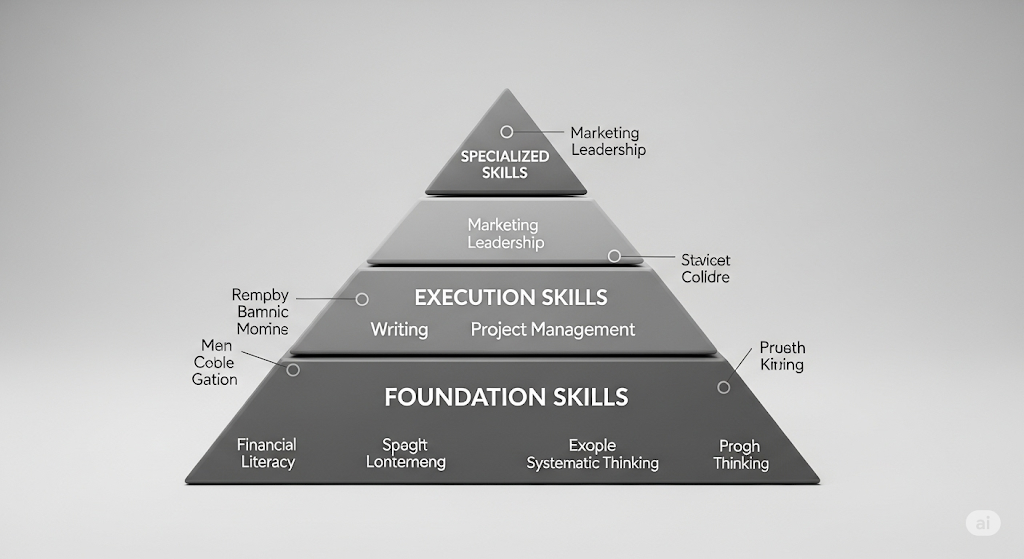The 80% Rule: Why 'Good Enough' Beats Perfect Every Time (Part 2)
Go beyond theory with the 80% Rule. Learn the 4-week SAFE framework to master any skill your business needs. Backed by science, built for entrepreneurs.

Summary
Part 2 provides a research-backed framework for applying the 80% Rule to any skill, drawing from cognitive science and accelerated learning principles. You'll discover the four-phase learning system that compresses months of traditional learning into 3-4 weeks, plus practical tools to identify which skills to tackle first. This isn't just theory—it's a systematic approach that leverages both human psychology and AI capabilities to transform how entrepreneurs acquire new competencies.
Key Points
- The SAFE Framework (Study, Apply, Feedback, Evolve) accelerates skill acquisition based on cognitive science
- "Deliberate practice" research shows specific techniques that compress learning timelines
- Most learning failures happen because people skip the foundation phase and jump to application
- The "competency cascade" effect means each new skill makes subsequent skills easier to acquire
- Modern AI tools work best when directed by someone with solid fundamentals (the 80% threshold)
Key Takeaways
- Use the systematic 4-week framework rather than hoping inspiration will strike
- Choose your first skill based on "learning leverage"—skills that unlock other skills
- Expect weeks 2-3 to be the hardest; this is normal and temporary
- Document your learning process to build confidence and refine your approach
- Start immediately with one specific skill rather than planning multiple skills
In Part 1, I shared how discovering the 80% Rule transformed my relationship with learning new skills. But knowing the principle isn't enough—you need a systematic way to apply it. Today, I'll give you the exact framework that's allowed me to repeatedly learn skills I once thought were beyond my reach, backed by research from cognitive science and accelerated learning.
More importantly, we'll tackle the question every entrepreneur asks but rarely answers honestly: "Which skill should I learn first?"
The SAFE Framework: Your 4-Week Learning System
After analyzing my own learning successes and failures—from Excel mastery to AI tool development—I've identified a pattern that consistently works. I call it the SAFE Framework, and it's designed around how our brains actually acquire new competencies.

Week 1: Study (Foundation Building)
This is where most people go wrong. They skip the foundation and jump straight to "doing," then wonder why they struggle.
The Research Behind It: Cognitive load theory shows that our working memory can only handle 7±2 pieces of new information simultaneously. When you try to learn by doing without a foundation, you overwhelm this system and create frustration rather than competence.
What This Looks Like in Practice:
My Excel breakthrough happened when I stopped trying to build complex workbooks and instead spent time understanding existing ones. I wasn't being lazy—I was following what researchers call "worked example effects." Studies show that studying completed examples before attempting problems improves learning speed by 30-40%.
Here's your Week 1 action plan:
- Find 5-10 excellent examples of the skill being executed well
- Deconstruct each example to understand the underlying logic and patterns
- Create a personal reference library of techniques, frameworks, and approaches
- Resist the urge to start creating your own work yet
For entrepreneurs specifically: If you're learning marketing, study 10 successful campaigns in your industry. If it's financial modeling, find and dissect 5 business plan financial sections. If it's sales, watch or read transcripts of top performers in action.
Week 2-3: Apply (Deliberate Practice Phase)
This is where the magic happens—and where most people want to quit.
The Research Behind It: Anders Ericsson's work on deliberate practice shows that improvement happens fastest when you work at the edge of your current ability with immediate feedback. The key isn't just practicing—it's practicing the right things in the right way.
Why Weeks 2-3 Are Brutal: Your brain is forming new neural pathways while breaking old patterns. Neuroscience research shows this process is inherently uncomfortable. The frustration you feel isn't a sign you should quit—it's evidence that learning is happening.
Your Week 2-3 Action Plan:
- Start with simplified versions of real problems
- Seek feedback early and often (even if it's just self-evaluation against your reference examples)
- Document your mistakes and the patterns you discover
- Push through the "I'm terrible at this" phase (this typically peaks in Week 2)
Personal Example: When learning to work with AI for business tools, my Week 2-3 projects were disasters. Simple automation tools that should got the work done in a moment barely worked or took much longer. But I was learning the difference between what AI could handle independently versus what needed human guidance. That distinction became the foundation for everything I built later.

Week 4: Feedback (Refinement and Integration)
The Research Behind It: The "testing effect" from cognitive psychology shows that actively retrieving and applying knowledge strengthens neural pathways more than passive review. Week 4 is about solidifying what you've learned and identifying gaps.
Your Week 4 Action Plan:
- Apply your skill to a real business problem (not just practice exercises)
- Compare your work to professional examples you studied in Week 1
- Identify the 2-3 areas where you're still weakest
- Create your own simplified process for future applications
Ongoing: Evolve (AI-Augmented Improvement)
This is where the 80% Rule becomes truly powerful in 2025.
The Modern Reality: Once you reach 80% competency, AI can handle much of the remaining complexity. But this only works if you have enough foundational knowledge to direct AI effectively, evaluate its output, and catch its mistakes.
Real Example from My Business: I now use AI to generate complex financial models, but I learned enough Excel and financial planning fundamentals to know when the AI's calculations are wrong or when its assumptions don't fit my business context. The 80% knowledge makes me an effective AI collaborator rather than a passive user.
The Learning Leverage Map: Which Skill Should You Tackle First?
Here's the simple question most entrepreneurs never ask: Which skills unlock other skills?
I call this "learning leverage"—the multiplier effect where one competency makes subsequent learning easier. Based on my experience and observation of successful entrepreneurs, here's how to prioritize:

Tier 1: Foundation Skills (Learn These First)
- Basic Financial Literacy: Understanding P&L, cash flow, and unit economics
- Systematic Thinking: Breaking complex problems into manageable components
- Research and Information Synthesis: Finding, evaluating, and connecting information
Why These First: Every other business skill builds on these foundations. You can't effectively learn marketing without understanding unit economics. You can't master sales without systematic thinking about customer problems.
Tier 2: Execution Skills (Learn After Foundations)
- Written Communication: Clear, persuasive business writing
- Basic Digital Tools: Whatever technology stack your industry requires
- Project Management: Planning and executing complex initiatives
Tier 3: Specialized Skills (Learn Based on Business Needs)
- Advanced Marketing/Sales Techniques
- Industry-Specific Technical Skills
- Team Leadership and Management
The Strategic Insight: Most entrepreneurs do this backwards. They jump to specialized skills without building foundations, then wonder why they struggle to integrate different aspects of their business.
The Mental Exercise: Your Personal Learning Audit
Before you choose your first skill, complete this reflection exercise. It's designed to surface both your assumptions and your actual learning history.
Part 1: Historical Analysis
Write down answers to these questions:
- Think of one skill you learned as an adult that initially seemed impossible. How did you actually learn it? What was your process?
- Identify a skill you currently assume you "can't learn." What evidence do you have for this assumption? Have you actually tried to learn it systematically?
- Consider someone in your industry you admire. What specific skills make them effective? Which of these skills have you never attempted to develop?
Part 2: Current Business Assessment
- List the top 5 decisions you make in your business (or will make when you start). For each decision, ask: "What knowledge would make this decision significantly better?"
- Identify your current bottlenecks. What are you outsourcing or avoiding because you assume you lack the skill? What's the real cost of this outsourcing—both financial and strategic?
- Look at your last month's biggest frustrations. How many of these could be reduced if you had better foundational skills?
Part 3: Learning Leverage Calculation
For each skill you've identified, rate it on two factors (1-10 scale):
- Business Impact: How much would 80% competency in this skill improve your business?
- Learning Leverage: How much would this skill accelerate learning other skills?
Multiply these scores. The highest-scoring skill is your starting point.
The Expectation Calibration: What 80% Really Looks Like
Let me be specific about what "80% competency" means in practice, because setting the right expectations is crucial for staying motivated.
In Excel/Financial Modeling (My L&T Example):
- 80% meant I could build most models needed for project planning
- I couldn't create the most sophisticated macros or advanced pivot table configurations
- But I could handle 90% of our daily work and knew when to seek help for the remaining 10%
In Business Planning (My Ola Experience):
- 80% meant I could develop marketing strategies that performed competitively
- I wasn't the most creative campaign designer in the company
- But I understood the fundamentals well enough to evaluate others' work and make strategic decisions
In AI Tool Development (Current Example):
- 80% means I can build functional business tools and automate workflows
- I can't create complex software products or solve advanced technical problems
- But I can serve as an effective product manager and direct technical resources appropriately
The Pattern: 80% competency means you're no longer dependent on others for basic execution, you can evaluate expert work intelligently, and you can handle most routine applications of the skill.
The Compound Effect: Why Each Skill Makes the Next One Easier
Here's something I didn't expect when I started deliberately learning new skills: each one made subsequent learning faster and easier.
The Competency Cascade Effect: When you successfully apply the 80% Rule to one skill, you build what psychologists call "self-efficacy"—confidence in your ability to learn. But more importantly, you develop meta-learning skills: you get better at the process of learning itself.
Real Example: My Excel experience taught me how to deconstruct complex systems by studying examples. This same approach helped me learn business planning faster at Ola, and later accelerated my AI tool development. The learning process becomes a transferable skill.
For Entrepreneurs: This means your first skill choice matters enormously. Success with one creates a virtuous cycle where each subsequent skill becomes easier to acquire. Failure creates the opposite—a pattern of giving up that reinforces limiting beliefs.
The AI Multiplier: Why This Framework Is More Powerful Than Ever
The emergence of capable AI tools doesn't make human skills obsolete—it makes the 80% Rule more valuable. Here's why:
AI Needs Direction: Modern AI tools are incredibly powerful when guided by someone who understands the problem domain. Without that 80% foundation, you can't effectively prompt AI, evaluate its output, or catch its errors.
AI Handles the Grunt Work: Once you reach 80% competency, AI can handle much of the routine execution, freeing you to focus on strategy, creativity, and judgment—the uniquely human elements that create competitive advantage.
Real Example: My financial modeling now involves me providing the business logic and structure while AI handles the complex formulas and calculations. This is exponentially faster than either pure manual work or pure AI dependence.
Your 30-Day Implementation Plan
Here's how to start applying this framework immediately:
Week 1 (Study Phase):
- Day 1-2: Complete the mental exercise above and choose your first skill
- Day 3-7: Gather and study 5-10 excellent examples of this skill in action
Week 2-3 (Apply Phase):
- Daily practice: 45-60 minutes of deliberate practice
- Weekly check-in: Compare your progress to Week 1 examples
- Frustration management: Expect difficulty; document what you're learning
Week 4 (Feedback Phase):
- Real application: Use your skill to solve an actual business problem
- Gap analysis: Identify areas for AI assistance or continued learning
- Process documentation: Record what worked for future skill acquisition
The Entrepreneur's Advantage: Why You're Already Equipped for This
If you're serious about starting a business, you've already demonstrated the core attributes needed for rapid skill acquisition:
Risk Tolerance: You're willing to bet your time, money, and reputation on an uncertain outcome. Learning a new skill is a smaller, more controlled risk.
Problem-Solving Orientation: Entrepreneurs are natural problem-solvers. Skill acquisition is just problem-solving applied to your own capabilities.
Resource Constraints: Most entrepreneurs operate with limited resources, which actually accelerates learning. When you can't afford to outsource everything, you learn faster.
Long-term Thinking: Building a business requires thinking beyond immediate results. This same mindset makes you patient enough to invest 3-4 weeks in skill development for long-term advantage.
The question isn't whether you can learn new skills—it's whether you'll choose to. The 80% Rule gives you a systematic path from "I can't do that" to "I can handle this." In a world where AI can augment human competency like never before, that 80% threshold becomes your entry point to capabilities you never thought possible.
Start with one skill. Follow the SAFE Framework. Give yourself permission to be frustrated in weeks 2-3. And remember: if you can build a business, you can learn anything your business needs.
The only question left is: Which skill will you tackle first?
FAQ
Q: What if I don't have 45-60 minutes daily for skill development?
Even 20-30 minutes of focused practice can work, but you'll need to extend the timeline to 5-6 weeks. The key is consistency over intensity. Three focused 20-minute sessions weekly beats one unfocused 2-hour session.
Q: How do I know if I'm actually reaching 80% competency or just fooling myself?
Compare your work to the professional examples you studied in Week 1. Can you produce similar quality results? Can you spot errors in others' work? Can you teach the basics to someone else? These are reliable indicators of 80% competency.
Q: What if the skill I need doesn't have clear "examples" to study?
Break the skill down into components. Even soft skills like leadership have observable elements: how great leaders communicate, make decisions, handle conflicts. Find case studies, videos, or detailed descriptions of best practices.
Q: Should I try to learn multiple skills simultaneously to save time?
No. Research on cognitive load shows that dividing attention between multiple complex learning tasks significantly reduces effectiveness. Master one skill to 80% before starting another. The competency cascade effect makes each subsequent skill easier anyway.
Q: How do I maintain skills I've learned while acquiring new ones?
Use them regularly in your business context. The beauty of business skills is they're meant to be applied continuously. Schedule monthly reviews of previously learned skills to prevent decay.
Q: What if I reach Week 4 and still feel incompetent?
This often means you're comparing yourself to experts rather than to your starting point. Review your Week 1 baseline. Most people dramatically underestimate their progress. If you're still genuinely struggling, extend the timeline rather than giving up—some skills take 6-8 weeks to reach 80%.